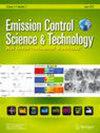了解影响柴油机微粒过滤器平衡点(及平衡点接近率)的因素:平衡点烟尘负荷的解析表达式
IF 1.3
Q3 ENGINEERING, CHEMICAL
引用次数: 1
摘要
本文章由计算机程序翻译,如有差异,请以英文原文为准。
Understanding Factors Affecting the Balance Point (and Rate of Balance Point Approach) of a Diesel Particulate Filter: an Analytical Expression for the Balance Point Soot Loading
求助全文
通过发布文献求助,成功后即可免费获取论文全文。
去求助
来源期刊

Emission Control Science and Technology
Engineering-Automotive Engineering
CiteScore
3.80
自引率
6.20%
发文量
11
期刊介绍:
Emission Control Science and Technology is a forum for publication of the latest research on control of emissions from mobile and stationary sources. Papers are also welcome on various aspects of development and technology. The investigation may be experimental, theoretical, or computational.
Articles must survive rigorous peer review before they are considered for publication. Examples of topics that may appear in the journal include:
Emission control in mobile (road, land, sea, air) and stationary (e.g. power generation, industrial processes) applications.
Materials for and formulations of novel substrates and catalysts, such as those used in Diesel Oxidation Catalyst (DOC), Three Way Catalysts (TWC), Diesel Particulate Filters (DPF), Selective Catalytic Reduction (SCR), Lean NOx Trap (LNT), combined catalysts (e.g. DPF+SCR or DPF+LNT in one substrate), slip catalysts, or reformer catalysts.
Performance of emission control system components such as sensors, injectors for fuel and reducing species, exhaust inserts and mixers, etc.
Effects of operational parameters (e.g. flow, temperature, species concentration) and design approaches (sizing, layout, insulation, etc) on regulated and unregulated emissions and emission control system efficiency and performance.
Basic and applied research on specific components (e.g. nanoparticles, N2O and other non-regulated pollutants) of emissions and their mitigation.
Studies on CO2 (or other greenhouse gases such as N2O) from combustion or non-combustion sources: Strategies or mitigations to control, reduce, utilize or manage
Studies on Direct Air Capture (DAC) of CO2, with or without utilizations or sequestration
System considerations such as engine-out to tailpipe efficiency, optimization, PGM management, and formation of secondary species.
Engines, combustion, fuels, or lubricants as they would affect emission reduction technologies or post combustion processes.
Testing, durability and compliance such as cycles, certification, aging, NVH, in-field (on-vehicle) performance and analysis, and in-use compliance.
Analysis of current and future emission regulations (including those in the developing world).
Biological and environmental effects of emission control technologies.
 求助内容:
求助内容: 应助结果提醒方式:
应助结果提醒方式:


